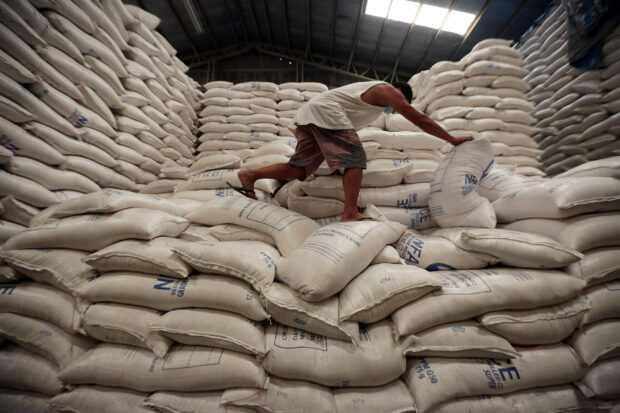Marcos: Will boost NFA rice stock with local sources, imports

Sacks of rice are stockpiled at the National Food Authority (NFA) warehouse in Quezon City.INQUIRER FILE PHOTO / GRIG C. MONTEGRANDE
President Ferdinand “Bongbong” Marcos Jr. said the rice supply at the National Food Authority (NFA) was “too low” and the government would have to boost its buffer stock with purchases from local producers and importations.
“In terms of the general supply for the country, I think we are in good shape. And although we’ll still have to import, our importations have come down,” the President said after his meeting with NFA and agriculture officials in Malacañang on Thursday.
Press Secretary Cheloy Velicaria-Garafil said the NFA had been proposing the importation of 330,000 metric tons of rice for a nine-day supply to cover an “expected deficit” in the country’s buffer stock for the relief operations if calamities strike this year.
Given the NFA’s “budgetary constraints,” its buffer stock will decrease to less than 500,000 sacks by July 2023, which is equivalent to less than a day of public consumption, she said.
“We will make plans whether we need to import, whether we need to extend, whether we need to increase the NFA buffer stock because it is already too low,” Mr. Marcos, who is also the agriculture secretary, said in an interview with Garafil.
“That is the only problem we see, the NFA buffer stock is low. The NFA needs to buy so the buffer stock would be enough for at least nine days,” he said.
‘No need to import’
Peasant groups lambasted the NFA’s proposed importation, saying that the agency should instead buy more rice from local farmers.
Jayson Cainglet, executive director of Samahang Industriya ng Agrikultura (Sinag), said importation at this point was unnecessary as the existing stocks were sufficient to tide the country through to August.
“Why doesn’t NFA purchase palay from farmers and have it milled by them?” Cainglet said. “There is no need to import. Our stocks, without importation, is good until August.”
He said that the landed cost, or the cost associated with shipping a product, has climbed to P36 per kilogram, much higher than locally produced rice, which ranges in price from P20 to P21 per kg.
Cathy Estavillo, secretary general of Amihan National Federation of Peasant Women and spokesperson for Bantay Bigas, said it was the NFA’s mandate to directly buy from local farmers to ensure that it would have a sufficient buffer stock.
“It is the harvest season, and they should think about how to raise local palay procurement,” she said.
Rafael Mariano, chair emeritus of Kilusang Magbubukid ng Pilipinas (KMP), asked why it was the NFA itself that was pushing for importations instead of helping, along with the Department of Agriculture, boost the volume of domestic rice production.
Palay price up
Amihan and Bantay Bigas said the NFA’s local procurement was equivalent to only 2.3 percent of the average annual production between 2018 and 2022.
KMP said “there is an imperative need to hike the local palay procurement to reach at least 20 percent” of the NFA stock. “Doing this will boost the local rice industry, and aid Filipino rice farmers,” KMP added.
As of January this year, the farm-gate price of palay stood at P17.73 per kg, up by 3.4 percent from P17.15 per kg a year ago, according to data from the Philippine Statistics Authority.
Sinag and KMP pointed out the NFA’s pronouncement was contrary to the President’s statement that the Philippines has ample rice supply.
In 2022, the country’s palay production was 19.76 million MT and rice imports totaled 3.83 million MT. A year prior, it was 19.96 million MT and 2.98 million MT, respectively.
The Bureau of Plant Industry reported that the country had already imported 663,806 MT of rice, mainly from Vietnam, as of March 23 this year.
Albay Rep. Joey Salceda said that with rice prices going down globally, it may be a good time for the government to bolster its buffer stock ahead of El Niño, which is expected to be felt later this year.
He supported calls for the NFA to boost its buffer stock with domestic rice. Imports should be limited to lean months of July and August, he added.
Salceda said in a statement that global rice prices went down by 3.2 percent from February to March this year and that he expected these to be “very close to pre-pandemic levels by July or August.”
“The trend shows significant price reductions as the world fertilizer markets adjust better to the now-stagnant Ukraine situation. If a rice price downtrend affects local farm-gate prices, although I don’t think they will by much, the NFA can also undertake a highly targeted buying program to support prices in certain areas,” Salceda said.
—WITH REPORTS FROM JORDEENE B. LAGARE, JULIE M. AURELIO AND INQUIRER RESEARCH
RELATED STORIES
NFA’s proposal to import rice goes against its own mandate — farmer group